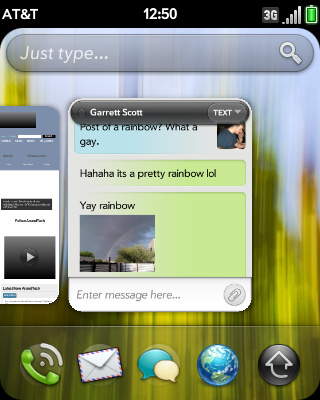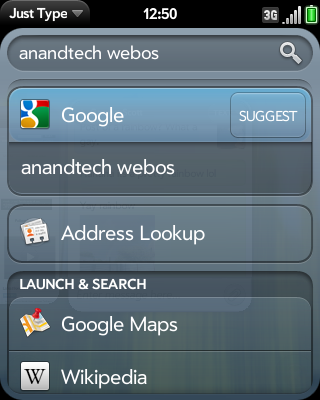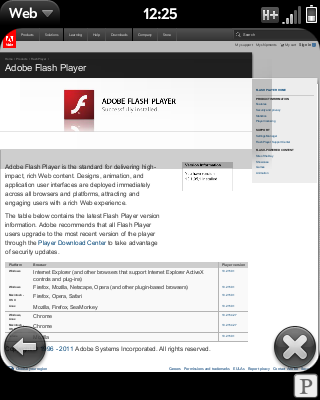HP Veer 4G Review - Getting Us Excited for Pre 3
by Brian Klug on June 7, 2011 5:01 PM EST- Posted in
- Smartphones
- HP
- AT&T
- Palm
- veer
- webOS
- HSPA+
- Mobile
- HP Veer 4G
I'm not going to go into super deep detail about what's changed in WebOS 2.0 because our own Mithun has already done an awesome job going over the differences in much better detail than I could in an earlier piece for AnandTech.
That said I think it's still important to go over the higher level software changes just for the sake of doing so, and again make some comparisons to the Pixi. Side by side with the Pixi running WebOS 1.0 and the Veer running WebOS 2.0 something immediately stood out. In WebOS 2.0 there now is a "just type..." search logo at the top of the card view screen, and cards are appropriately smaller underneath it. My friend who uses a Pixi daily at first insisted that the Veer's screen was smaller (they're the same size) which was confusing until I realized that the discrepancy in card size when in the card view zom level is rather dramatic. See for yourself:
.png)

Left: Palm Pixi (WebOS 1.0), Right: HP Veer (WebOS 2.0)
The screen size and resolution between the two is exactly the same, howver the addition of the "Just type..." search bar at the top of the WebOS 2.0 view results in dramatically smaller cards. When it comes to the messaging application and others, this often made the difference in terms of whether text inside the card was readable or not. You can really see just how much smaller the cards are now, and the Veer's very square aspect ratio accentuates the problem. I get the impression this was a feature designed on and for the Pre 3 with a much more rectangular aspect ratio.

The improvements to the "Just type" search system are actually very good, with google suggestions populating the list, prompts to add new search engines whenever they're encountered on webpages, and more local application searching.
The other major improvement is Flash support in WebOS 2.0. It's enabled out of the box, though by default Flash elements are not preloaded and played, though you can enable this functionality. By default, you get grey boxes with a play symbol where Flash lives.


Tap on them, and Flash starts running, and the browser locks its current zoom level and translation so you can interact purely with the Flash element. Tapping on the X in the bottom right corner doesn't stop the Flash plugin, it gives focus back to the browser so you can multitouch translate and zoom around again. This is honestly a superior implementation to Android's unstated hybrid of the two.
Quite honestly other than the lack of any improvements in boot time (reasons for which we will get into in a few pages), I found that WebOS 2.0 is a decent step forward that's mostly incremental. To be completley honest, WebOS 2.0 feels more like WebOS 1.5 than a big update that really warrants a full version change. I understand what HPalm is trying to do here though, and for the most part I'm pleased with the changes - there just needs to be even more of them, faster. Android and iOS both are borrowing from WebOS more and more each update.
In the Touchstone the Veer also goes into exhibition view, even if right now it's essentially just the default display Mithun already showed in his own WebOS 2.0 exploration. I couldn't quickly find any examples of applications that leverage this view, but it's just one of the interesting innovations I feel like WebOS is pushing that it has to capitalize on before others beat it to the punch.











25 Comments
View All Comments
ClockerXP - Saturday, June 11, 2011 - link
Dial ##3-836# to get to the menu where you can disable 3G. Works on my Pre+ on Verizon!ClockerXP - Saturday, June 11, 2011 - link
I mean ##3836# (no dash)dananski - Sunday, June 12, 2011 - link
I agree that the hardware is better than people say. I haven't had any problems with mine and it only has minor scratches from all the times I've dropped it. But the OS is good too. Cards and synergy are two things I couldn't go without, and I like the simple gestures.ioannis - Tuesday, June 7, 2011 - link
Brian, thanks for the comprehensive review, delivered in the usual Anandtech quality.The App Catalogue compatibility seems to be the only major complain I'd have over this phone. My question is, will WebOS 3.0 with the Enyo framework come to the Veer? And assuming that all the apps eventually get ported to it (or at least all apps released from the time 3.0 is out will be based on it), would that solve the 'pixel density'/resolution-dependent apps problem?
softdrinkviking - Tuesday, June 7, 2011 - link
Hi Brian. Great review. I especially liked your explanation of HSPA+, nice work there.I had one question. You again referred to Super LCD as (IPS) in this article, as you did in the article a few days ago (HTC evo 3D). In that article you crossed out the (IPS) and I assumed that meant you were reassessing that. Have you come to any conclusions about Super LCD and what process it is made with?
Brian Klug - Tuesday, June 7, 2011 - link
So I was mistaken earlier about Super LCD being IPS, I went over my notes and have written down that Super LCD is just PVA. I'm going to try and do some more digging to find out why I have that here and what the implications are. Honestly though the SLCD display on the Sensation looks quite good.-Brian
Solidstate89 - Tuesday, June 7, 2011 - link
I haven't owned a WebOS phone because of the flakiness of the hardware, but the OS has always appealed to me. Similarly although the Veer isn't for me, I do like just how much better WebOS 2.0 is looking.I sincerely wish them the best in the market as it is quite simply a brilliantly designed OS. However it's just taken too long to get to market. I wanted to get a Pre 3 on Verizon, but realized it would be too late with Verizon Wireless nixing its Unlimited Data plans before it could be released so I went to sprint and picked up a WP7 device.
Quite happy with it, and although it's a blatant rip-off, I can't wait for the card-style multitasking to arrive with the Mango Update :)
Best of luck to WebOS.
softdrinkviking - Tuesday, June 7, 2011 - link
cool, thanks for the reply & info. i have seen plenty of PVA screens in the store and they look pretty good to me, maybe not as good as the high-end NECs and other professional monitors, but i had a hard time telling the difference between the led backlit LG IPS and the similar sized BenQ with a PVA. (this is in Japan, so i can't say what models you have in the states).As long as they are good quality, and a decent resolution, I can't imagine that PVA would be unacceptable on a cel phone. they are undoubtedly better than TN.
jamawass - Wednesday, June 8, 2011 - link
I think the veer makes sense if you take into consideration hp's tablet strategy. A veer with mobile hotspot would be an excellent combo with a 7 in touchpad ( to be released after the 10 in later this yr). I have a 7 in sony reader which fits in all my jacket's pockets. That's my device of choice when I'm waiting at the auto shop, etc and I always receives glances when I whip it out of my jacket. It's light, and much more portable than an ipad.I suspect this is one of hp's strategies with the veer and I wouldn't be surprised if they market them as a combo deal in the future.
I've used webos for a year now and generally like it's efficiency, but Apple and other companies have been cannibalising their innovations. As stated above, hp needs to accelerate the upgrade cycle in both soft and hardware to survive.
marc1000 - Wednesday, June 8, 2011 - link
Brian and Anand, I could not find a way to contact you. So I will write this down on the comment section.Microsoft is killing the only thing cool on all older WindowsMobile phones (6.5 & below): the MyPhone service will die in a couple months.
please read this thread at XDA where some users reported receiving the same MS email with the news.
http://forum.xda-developers.com/showthread.php?t=1...